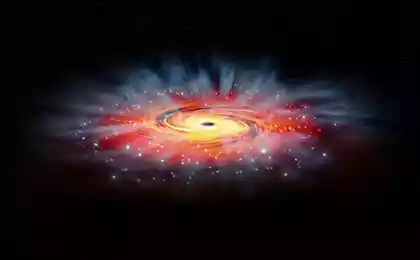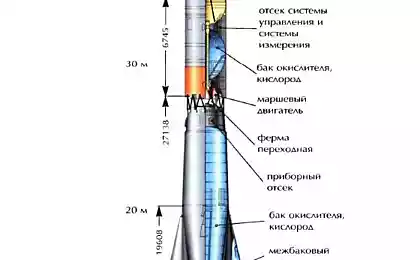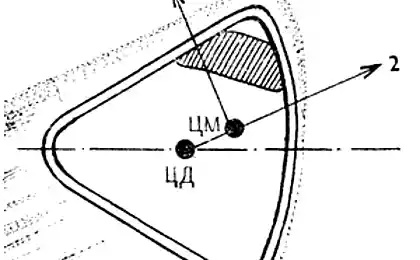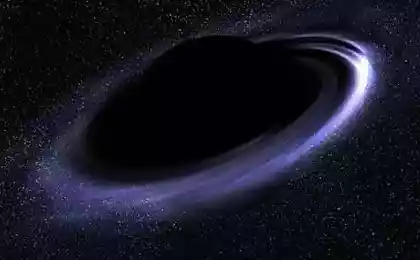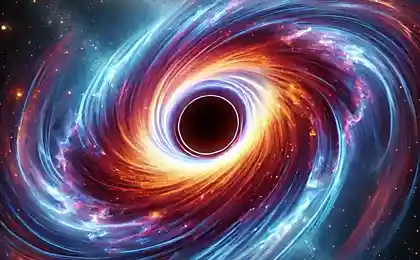1107
10 amazing facts about black holes
1. The first assumption of the existence of black holes made by John Mitchell
Most believe that the discovery of the existence of black holes - the merit of Albert Einstein.
However, Einstein completed his theory to the 1916-th year, and John Mitchell pondered the idea in far 1783 m. She did not find the application because the English clergyman did not know what to do with it.
Mitchell began to develop the theory of black holes, when he took the idea of Newton, according to which light consists of small material particles, called photons. He was thinking about the movement of light particles and concluded that it depends on the gravitational field of the star, which they leave. He was trying to understand what happens to these particles, if the gravitational field is too large to allow light to leave it.
Mitchell is also the founder of modern seismology. He suggested that the earthquake spread like waves in the ground.
2. They really draw the space around sebya
Try to space in the form of a rubber sheet. Imagine that the world - is the balls, which put pressure on the sheet. It deforms and is no longer straight lines. This creates a gravitational field, and explains why the planets move around the stars.
If the mass of the object will increase, the deformation space can be even larger. These additional perturbations increase the force of gravity and accelerate the orbital motion, causing the satellite to move objects around faster and faster.
For example, Mercury moves around the sun at a speed of 48 km / s, while the orbital velocity of the stars near the black hole at the center of our galaxy reaches 4800 km / s.
If the force of gravity is strong enough, then the satellite is facing a large-sized object.
3. Not all black holes odinakovy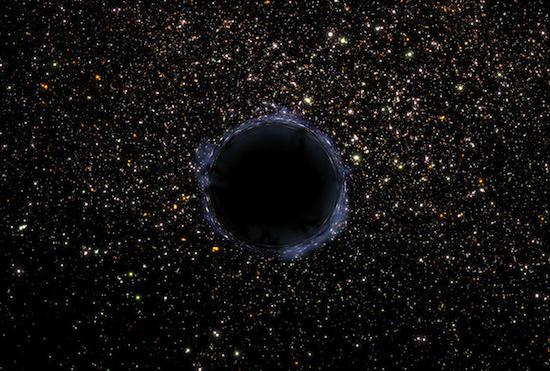
We usually think that all black holes are in fact one and the same. However, astronomers have recently found out that they can be divided into several varieties.
There are rotating black holes, black holes with electric charge and black holes, including the features of the first two. Ordinary black holes occur by absorption of matter, and a rotating black hole formed by the merger of two of the holes.
These black holes consume much more energy due to increased perturbation space. Charged rotating black hole acts like a particle accelerator.
The black hole, called GRS 1915 + 105, located about 35,000 light years from Earth. It rotates at a speed of 950 revolutions per second.
4. Their density is incredibly vysoka
Black holes need to be extremely massive at incredibly small sizes to create large enough to contain the force of gravity of the world. For example, if you make a black hole mass equal to the mass of the Earth, you get a ball with a diameter of 9 mm.
The black hole whose mass is 4 million times the mass of the Sun, can fit in the space between Mercury and the sun. The black hole at the center of galaxies can have a mass greater than the Sun from 10 to 30 million times.
Such a large mass in such a small space means that black holes are incredibly greater density and the forces acting within them, they are also very strong.
5. They are quite shumnye
Everything that surrounds the black hole drags into the abyss and at the same time accelerating. The event horizon (the boundary of space-time from which the information can not reach the observer from the finite speed of light; approx. Mixstuff) accelerates particles to almost the speed of light.
While crossing the center of the event horizon matter arises gurgling sound. This sound is a transformation of the energy of motion into sound waves.
In 2003, astronomers using the Chandra observations recorded sound waves coming from the supermassive black hole at a distance of 250 million light years.
6. Nothing can escape from their prityazheniya
When something (it could be a planet and a star and galaxy, and the particle of light) passes close enough to the black hole, that object will inevitably be captured by its gravitational field. If something else acting on an object, say, a missile, stronger attractive forces of the black hole, it will be able to avoid absorption.
Until then, of course, until it reaches the event horizon. The points after which leave a black hole is impossible. To leave the event horizon, it is necessary to develop a speed greater than the speed of light, but this is impossible.
This is the dark side of a black hole - if light can not leave it, then we will never be able to look inside.
Scientists believe that even a small black hole will tear you to pieces long before you get through the event horizon. The attractive force is greater, the closer you are to the planet, star or a black hole. If you are flying to a black hole kicked forward, the power of attraction in your feet will be much larger than the head. That tear you apart.
7. They slow vremya
Light bends around the event horizon, but, ultimately, it is captured into oblivion when penetrates.
You can describe what happens with the clock, if they fall into the black hole and survive there. As we approach the event horizon, they will slow down and eventually stop completely.
This freezing of time is due to gravitational time dilation, which is explained by the theory of relativity. The force of attraction to the black hole is so large that it can slow down time. In terms of hours, everything is going fine. Hours lost from sight, while the light from them will be more stretched. Light will become more red wavelength will increase and in the end he will go beyond the visible spectrum.
8. They are perfect manufacturers energii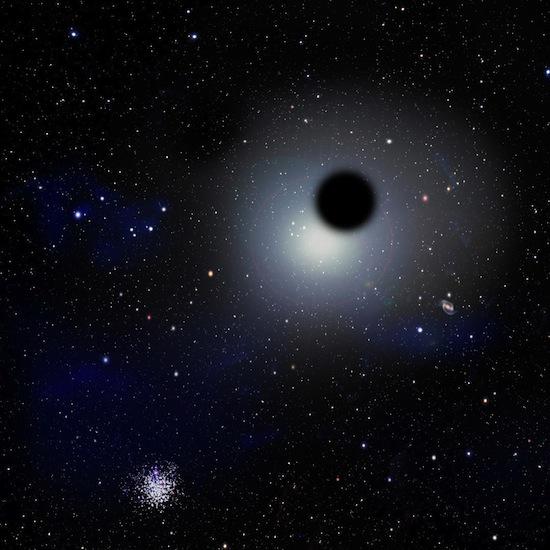
Black holes suck in all of the surrounding ground. Inside a black hole everything is compressed so much that the space between the individual elements of the atoms is compressed, resulting in formation of subatomic particles that can fly out. These particles are pulled out from a black hole because of the magnetic field lines crossing the event horizon.
Isolation of energy particles generates fairly efficient way. The conversion of mass into energy in this way is 50 times much more efficient than nuclear fusion.
9. They limit the number of zvёzd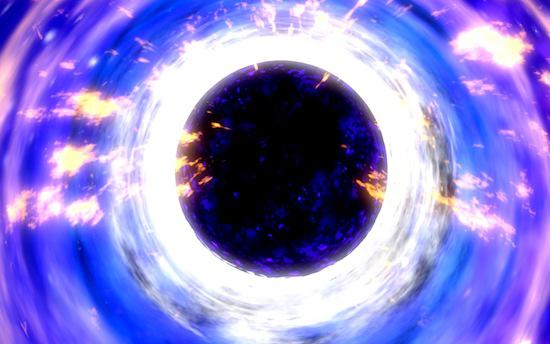
Once known astrophysicist, Carl Sagan, he said, in the universe more stars than grains of sand on the beaches around the world. But it seems that in the universe of all star in 1022.
This number is determined by the number of black holes. Streams of particles produced by black holes, expand to bubbles that spread through the region of star formation. Areas of star formation - are areas of gas clouds, which can be cooled to form stars. Flows of these particles are heated clouds of gas and prevent the emergence of stars.
This means that there is a balanced ratio between the number of stars and black hole activity. A very large number of stars in the galaxy are located will make it too hot and explosive for the development of life, but too small number of stars does not contribute to the emergence of life.
10. We are composed of the same materiala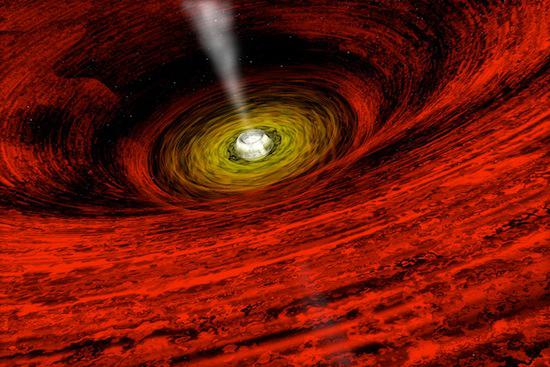
Some researchers believe that black holes will help us to create new elements, because they break up the matter at the subatomic particles.
These particles are involved in the formation of stars, which in turn leads to the creation of elements heavier than helium, such as iron and carbon required for the formation of solid planets and life. These elements are part of everything that has mass, which means you and me.
Source: www.mixstuff.ru
via factroom.ru

Most believe that the discovery of the existence of black holes - the merit of Albert Einstein.
However, Einstein completed his theory to the 1916-th year, and John Mitchell pondered the idea in far 1783 m. She did not find the application because the English clergyman did not know what to do with it.
Mitchell began to develop the theory of black holes, when he took the idea of Newton, according to which light consists of small material particles, called photons. He was thinking about the movement of light particles and concluded that it depends on the gravitational field of the star, which they leave. He was trying to understand what happens to these particles, if the gravitational field is too large to allow light to leave it.
Mitchell is also the founder of modern seismology. He suggested that the earthquake spread like waves in the ground.
2. They really draw the space around sebya

Try to space in the form of a rubber sheet. Imagine that the world - is the balls, which put pressure on the sheet. It deforms and is no longer straight lines. This creates a gravitational field, and explains why the planets move around the stars.
If the mass of the object will increase, the deformation space can be even larger. These additional perturbations increase the force of gravity and accelerate the orbital motion, causing the satellite to move objects around faster and faster.
For example, Mercury moves around the sun at a speed of 48 km / s, while the orbital velocity of the stars near the black hole at the center of our galaxy reaches 4800 km / s.
If the force of gravity is strong enough, then the satellite is facing a large-sized object.
3. Not all black holes odinakovy

We usually think that all black holes are in fact one and the same. However, astronomers have recently found out that they can be divided into several varieties.
There are rotating black holes, black holes with electric charge and black holes, including the features of the first two. Ordinary black holes occur by absorption of matter, and a rotating black hole formed by the merger of two of the holes.
These black holes consume much more energy due to increased perturbation space. Charged rotating black hole acts like a particle accelerator.
The black hole, called GRS 1915 + 105, located about 35,000 light years from Earth. It rotates at a speed of 950 revolutions per second.
4. Their density is incredibly vysoka

Black holes need to be extremely massive at incredibly small sizes to create large enough to contain the force of gravity of the world. For example, if you make a black hole mass equal to the mass of the Earth, you get a ball with a diameter of 9 mm.
The black hole whose mass is 4 million times the mass of the Sun, can fit in the space between Mercury and the sun. The black hole at the center of galaxies can have a mass greater than the Sun from 10 to 30 million times.
Such a large mass in such a small space means that black holes are incredibly greater density and the forces acting within them, they are also very strong.
5. They are quite shumnye

Everything that surrounds the black hole drags into the abyss and at the same time accelerating. The event horizon (the boundary of space-time from which the information can not reach the observer from the finite speed of light; approx. Mixstuff) accelerates particles to almost the speed of light.
While crossing the center of the event horizon matter arises gurgling sound. This sound is a transformation of the energy of motion into sound waves.
In 2003, astronomers using the Chandra observations recorded sound waves coming from the supermassive black hole at a distance of 250 million light years.
6. Nothing can escape from their prityazheniya

When something (it could be a planet and a star and galaxy, and the particle of light) passes close enough to the black hole, that object will inevitably be captured by its gravitational field. If something else acting on an object, say, a missile, stronger attractive forces of the black hole, it will be able to avoid absorption.
Until then, of course, until it reaches the event horizon. The points after which leave a black hole is impossible. To leave the event horizon, it is necessary to develop a speed greater than the speed of light, but this is impossible.
This is the dark side of a black hole - if light can not leave it, then we will never be able to look inside.
Scientists believe that even a small black hole will tear you to pieces long before you get through the event horizon. The attractive force is greater, the closer you are to the planet, star or a black hole. If you are flying to a black hole kicked forward, the power of attraction in your feet will be much larger than the head. That tear you apart.
7. They slow vremya

Light bends around the event horizon, but, ultimately, it is captured into oblivion when penetrates.
You can describe what happens with the clock, if they fall into the black hole and survive there. As we approach the event horizon, they will slow down and eventually stop completely.
This freezing of time is due to gravitational time dilation, which is explained by the theory of relativity. The force of attraction to the black hole is so large that it can slow down time. In terms of hours, everything is going fine. Hours lost from sight, while the light from them will be more stretched. Light will become more red wavelength will increase and in the end he will go beyond the visible spectrum.
8. They are perfect manufacturers energii

Black holes suck in all of the surrounding ground. Inside a black hole everything is compressed so much that the space between the individual elements of the atoms is compressed, resulting in formation of subatomic particles that can fly out. These particles are pulled out from a black hole because of the magnetic field lines crossing the event horizon.
Isolation of energy particles generates fairly efficient way. The conversion of mass into energy in this way is 50 times much more efficient than nuclear fusion.
9. They limit the number of zvёzd

Once known astrophysicist, Carl Sagan, he said, in the universe more stars than grains of sand on the beaches around the world. But it seems that in the universe of all star in 1022.
This number is determined by the number of black holes. Streams of particles produced by black holes, expand to bubbles that spread through the region of star formation. Areas of star formation - are areas of gas clouds, which can be cooled to form stars. Flows of these particles are heated clouds of gas and prevent the emergence of stars.
This means that there is a balanced ratio between the number of stars and black hole activity. A very large number of stars in the galaxy are located will make it too hot and explosive for the development of life, but too small number of stars does not contribute to the emergence of life.
10. We are composed of the same materiala

Some researchers believe that black holes will help us to create new elements, because they break up the matter at the subatomic particles.
These particles are involved in the formation of stars, which in turn leads to the creation of elements heavier than helium, such as iron and carbon required for the formation of solid planets and life. These elements are part of everything that has mass, which means you and me.
Source: www.mixstuff.ru
via factroom.ru
There is swelling, which can grow eyes, hair, teeth and muscle tissue
To neutralize the sharpness, eat a spoonful of sugar


